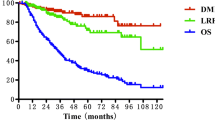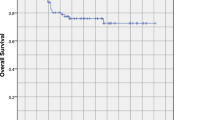Abstract
Background
This study aimed to reveal the long-term outcomes and late toxicities (> 5 years) after definitive intensity-modulated radiation therapy (IMRT) in patients with nasopharyngeal carcinoma (NPC).
Methods
Data from 43 patients (median age, 55 years; range, 17–72 years) with NPC who underwent definitive IMRT between 2001 and 2018 were analyzed. All patients were alive and disease-free 5 years after IMRT. A total dose of 70 (range, 66–70) Gy was delivered in 35 (33–35) fractions with concurrent cisplatin chemotherapy.
Results
The median follow-up duration was 119 (range, 61.5–242.1) months. Three patients developed locoregional failure at 79, 92, and 149 months after IMRT, respectively. Of these, 2 patients died of disease progression at 136 and 153 months after IMRT. One patient died of aspiration pneumonia 141 months after IMRT, despite salvage of the recurrent tumor by re-irradiation. In addition, one patient died of aspiration pneumonia 62 months after the IMRT. Thus, the 10-year overall survival, progression-free survival, and locoregional control rates were 98%, 92%, and 94%, respectively. Grade ≥ 2 and ≥ 3 late toxicities were observed in 28 (65%) and 9 (21%) patients, respectively. Nine second primary cancers, including five tongue cancers and two external auditory canal carcinomas, were observed in seven (16%) patients.
Conclusion
Late recurrences, severe late toxicities, and second primary cancers were observed > 5 years after IMRT. A long-term follow-up of > 5 years is needed in patients with NPC.


Similar content being viewed by others
References
Chen YP, Ismaila N, Chua MLK et al (2021) Chemotherapy in combination with radiotherapy for definitive-intent treatment of stage II-IVA nasopharyngeal carcinoma: CSCO and ASCO guideline. J Clin Oncol 39:840–859. https://doi.org/10.1200/JCO.20.03237
Nishimura Y, Ishikura S, Shibata T et al (2020) A phase II study of adaptive two-step intensity-modulated radiation therapy (IMRT) with chemotherapy for loco-regionally advanced nasopharyngeal cancer (JCOG1015). Int J Clin Oncol 25:1250–1259. https://doi.org/10.1007/s10147-020-01665-2
Nishimura Y, Shibata T, Nakamatsu K et al (2010) A two-step intensity-modulated radiation therapy method for nasopharyngeal cancer: The Kinki University experience. Jpn J Clin Oncol 40:130–138. https://doi.org/10.1093/jjco/hyp136
Kam MKM, Leung SF, Zee B et al (2007) Prospective randomized study of intensity-modulated radiotherapy on salivary gland function in early-stage nasopharyngeal carcinoma patients. J Clin Oncol 25:4873–4879. https://doi.org/10.1200/JCO.2007.11.5501
Lee AW, Ng WT, Chan LL et al (2014) Evolution of treatment for nasopharyngeal cancer–success and setback in the intensity-modulated radiotherapy era. Radiother Oncol 110:377–384. https://doi.org/10.1016/j.radonc.2014.02.003
Du T, Xiao J, Qiu Z et al (2019) The effectiveness of intensity-modulated radiation therapy versus 2D-RT for the treatment of nasopharyngeal carcinoma: a systematic review and meta-analysis. PLoS ONE 14:e0219611. https://doi.org/10.1371/journal.pone.0219611
Poon DMC, Kam MKM, Johnson D et al (2021) Durability of the parotid-sparing effect of intensity-modulated radiotherapy (IMRT) in early stage nasopharyngeal carcinoma: a 15-year follow-up of a randomized prospective study of IMRT versus two-dimensional radiotherapy. Head Neck 43:1711–1720. https://doi.org/10.1002/hed.26634
Chen L, Zhang Y, Lai SZ et al (2019) 10-year results of therapeutic ratio by intensity-modulated radiotherapy versus two-dimensional radiotherapy in patients with nasopharyngeal carcinoma. Oncologist 24:e38–e45. https://doi.org/10.1634/theoncologist.2017-0577
Wu X, Huang PY, Peng PJ et al (2013) Long-term follow-up of a phase III study comparing radiotherapy with or without weekly oxaliplatin for locoregionally advanced nasopharyngeal carcinoma. Ann Oncol 24:2131–2136. https://doi.org/10.1093/annonc/mdt163
Zhang MX, Li J, Shen GP et al (2015) Intensity-modulated radiotherapy prolongs the survival of patients with nasopharyngeal carcinoma compared with conventional two-dimensional radiotherapy: a 10-year experience with a large cohort and long follow-up. Eur J Cancer 51:2587–2595. https://doi.org/10.1016/j.ejca.2015.08.006
Zhi-Qiang W, Qi M, Ji-Bin L et al (2019) The long-term survival of patients with III-IVb stage nasopharyngeal carcinoma treated with IMRT with or without Nimotuzumab: a propensity score-matched analysis. BMC Cancer 19:1122
Niu X, Xue F, Liu P et al (2022) Long-term outcomes of nasopharyngea carcinoma patients with T1–2 stage in intensity-modulated radiotherapy era. Int J Med Sci 19:267–273. https://doi.org/10.7150/ijms.68394
Kanayama N, Otozai S, Yoshii T et al (2020) Death unrelated to cancer and death from aspiration pneumonia after definitive radiotherapy for head and neck cancer. Radiother Oncol 151:266–272. https://doi.org/10.1016/j.radonc.2020.08.015
Rosenthal DI, Lewin JS, Eisbruch A (2006) Prevention and treatment of dysphagia and aspiration after chemoradiation for head and neck cancer. J Clin Oncol 24:2636–2643. https://doi.org/10.1200/JCO.2006.06.0079
Petkar I, Rooney K, Roe JWG et al (2016) DARS: A phase III randomised multicentre study of dysphagia-optimised intensity- modulated radiotherapy (Do-IMRT) versus standard intensity- modulated radiotherapy (S-IMRT) in head and neck cancer. BMC Cancer 16:770. https://doi.org/10.1186/s12885-016-2813-0
Ashour MG, Shouman TH, Hassouna AH et al (2022) Swallowing sparing intensity modulated radiotherapy versus standard parotid sparing intensity-modulated radiotherapy for treatment of head and neck cancer: a randomized clinical trial. Acta Oncol 61:134–140. https://doi.org/10.1080/0284186X.2021.2022198
Coca-Pelaz A, Rodrigo JP, Suárez C et al (2020) The risk of second primary tumors in head and neck cancer: a systematic review. Head Neck 42:456–466. https://doi.org/10.1002/hed.26016
Wang CC, Chen ML, Hsu KH et al (2000) Second malignant tumors in patients with nasopharyngeal carcinoma and their association with Epstein-Barr virus. Int J Cancer 87:228–231. https://doi.org/10.1002/1097-0215(20000715)87:2%3c228::aid-ijc12%3e3.0.co;2-t
Kong L, Lu JJ, Hu C et al (2006) The risk of second primary tumors in patients with nasopharyngeal carcinoma after definitive radiotherapy. Cancer 107:1287–1293. https://doi.org/10.1002/cncr.22119
Li F, Chen FP, Chen YP et al (2020) Clinical characteristics and prognostic factors of early and late recurrence after definitive radiotherapy for nasopharyngeal carcinoma. Front Oncol 10:1469. https://doi.org/10.3389/fonc.2020.01469
Toumi N, Ennouri S, Charfeddine I et al (2021) Local and lymph node relapse of nasopharyngeal carcinoma: a single-center experience. Ear Nose Throat J 100:795S-800S. https://doi.org/10.1177/0145561320908955
Brierley JD, Gospodarowicz MK, Wittekind C (2017) TNM classification of malignant tumours. Wiley, Hoboken
Matsuura T, Nishimura Y, Nakamatsu K et al (2017) Clinical outcomes of IMRT planned with or without PET/CT simulation for patients with pharyngeal cancers. Int J Clin Oncol 22:52–58. https://doi.org/10.1007/s10147-016-1034-5
Common Terminology Criteria for Adverse Events (CTCAE), v.5.0. https://ctep.cancer.gov/protocoldevelopment/electronic_applications/docs/ctcae_v5_quick_reference_5x7.pdf. Accessed Dec 24, 2021
Lin YS, Jen YM, Lin JC (2002) Radiation-related cranial nerve palsy in patients with nasopharyngeal carcinoma. Cancer 95:404–409. https://doi.org/10.1002/cncr.10668
Chow JCH, Lui JCF, Au KH et al (2021) Application of hypoglossal nerve constraint in definitive radiotherapy for nasopharyngeal carcinoma: a dosimetric feasibility study. Med Dosim 46:39–44. https://doi.org/10.1016/j.meddos.2020.07.002
Périé S, Coiffier L, Laccourreye L et al (1999) Swallowing disorders in paralysis of the lower cranial nerves: a functional analysis. Ann Otol Rhinol Laryngol 108:606–611. https://doi.org/10.1177/000348949910800614
Eisbruch A, Schwartz M, Rasch C et al (2004) Dysphagia and aspiration after chemoradiotherapy for head-and-neck cancer: which anatomic structures are affected and can they be spared by IMRT? Int J Radiat Oncol Biol Phys 60:1425–1439. https://doi.org/10.1016/j.ijrobp.2004.05.050
Khanna L, Prasad SR, Yedururi S et al (2021) Second malignancies after radiation therapy: Update on pathogenesis and cross-sectional imaging findings. Radiographics 41:876–894. https://doi.org/10.1148/rg.2021200171
Hall EJ (2006) Intensity-modulated radiation therapy, protons, and the risk of second cancers. Int J Radiat Oncol Biol Phys 65:1–7. https://doi.org/10.1016/j.ijrobp.2006.01.027
Bray F, Haugen M, Moger TA et al (2008) Age-incidence curves of nasopharyngeal carcinoma worldwide: bimodality in low-risk populations and aetiologic implications. Cancer Epidemiol Biomarkers Prev 17:2356–2365. https://doi.org/10.1158/1055-9965.EPI-08-0461
Ng SP, Pollard C 3rd, Kamal M et al (2019) Risk of second primary malignancies in head and neck cancer patients treated with definitive radiotherapy. NPJ Precis Oncol 27(3):22. https://doi.org/10.1038/s41698-019-0097-y
Chen M-C, Feng I-J, Lu C-H et al (2008) The incidence and risk of second primary cancers in patients with nasopharyngeal carcinoma: a population-based study in Taiwan over a 25-year period (1979–2003). Ann Oncol 19:1180–1186. https://doi.org/10.1093/annonc/mdn003
Morris LGT, Sikora AG, Patel SG et al (2011) Second primary cancers after an index head and neck cancer: subsite-specific trends in the era of human papillomavirus-associated oropharyngeal cancer. J Clin Oncol 29:739–746. https://doi.org/10.1200/jco.2010.31.8311
Boakye EA, Buchanan P, Hinyard L et al (2018) Incidence and risk of second primary malignant neoplasm after a first head and neck squamous cell carcinoma. JAMA Otolaryngol Head Neck Surg 144:727–737. https://doi.org/10.1001/jamaoto.2018.0993
Goon P, Schürmann M, Oppel F et al (2022) Viral and clinical oncology of head and neck cancers. Curr Oncol Rep 24:929–942. https://doi.org/10.1007/s11912-022-01263-7
Mohamand O, Tabuchi T, Nitta Y et al (2019) Risk of subsequent primary cancers after carbon ion radiotherapy, photon radiotherapy, or surgery for localised prostate cancer: a propensity score-weighted, retrospective, cohort study. Lancet Oncol 20:674–685. https://doi.org/10.1016/S1470-2045(18)30931-8
Hamashima C (2018) Cancer screening guidelines and policy making: 15 years of experience in cancer screening guideline development in Japan. Jpn J Clin Oncol 48:278–286. https://doi.org/10.1093/jjco/hyx190
NCCN Clinical Practice Guidelines in Oncology (NCCN Guidelines®) Head and Neck Cancer Version 1. 2023 https://www.nccn.org/professionals/physician_gls/pdf/head-and-neck.pdf. Accessed March 23, 2023
Acknowledgements
The authors would like to acknowledge Editage (www.editage.jp) for the English language editing. This work was partially supported by JSPS KAKENHI, Grant Numbers JP 20K08009. The authors are grateful to Dr. Yasutaka Chiba from the Clinical Research Center, Kindai University Hospital, for his advice on statistical analysis.
Author information
Authors and Affiliations
Corresponding author
Ethics declarations
Conflict of interest
The authors declare that they have no conflict of interest.
Additional information
Publisher's Note
Springer Nature remains neutral with regard to jurisdictional claims in published maps and institutional affiliations.
About this article
Cite this article
Doi, H., Ri, A., Inada, M. et al. Clinical course of longer than five years after definitive radiotherapy for nasopharyngeal carcinoma. Int J Clin Oncol 28, 1607–1615 (2023). https://doi.org/10.1007/s10147-023-02418-7
Received:
Accepted:
Published:
Issue Date:
DOI: https://doi.org/10.1007/s10147-023-02418-7




